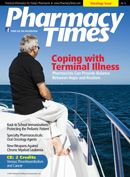Publication
Article
Pharmacy Times
OTC Case Studies: Self-Care for Cancer Patients


Mary Barna Bridgeman, PharmD
Rupal Patel, PharmD
Case 1—Dry Mouth Due to Radiation Treatment
CH is a 65-year-old woman who presents to your pharmacy seeking a recommendation for a saliva substitute product. Upon questioning, CH reports she has undergone radiation therapy of her head and neck region for treatment of throat cancer. She reports suffering from chronic dry mouth, which her oncologist attributed to damage to her salivary glands. Based on her oncologist’s recommendation, she is looking to purchase a saliva substitute for symptom relief. She denies allergies to medication or foods. She does not report dental pain, tooth erosion or decay, or systemic symptoms. Identify an appropriate artificial saliva product for CH to use. Describe appropriate nonpharmacologic recommendations to counsel her on how to alleviate dry mouth symptoms.
Answer
CH is likely suffering from xerostomia, or dry mouth, secondary to radiation-induced salivary gland dysfunction. Although a seemingly benign complaint, xerostomia can be associated with difficulty chewing and swallowing dry foods, loss of appetite, halitosis, candidiasis, and dental caries despite good oral hygiene.1,2
It would be prudent to counsel CH on lifestyle interventions in addition to recommending a saliva substitute to help alleviate symptoms and prevent tooth erosion and complications.
Recommend CH avoid products that contain alcohol and refrain from tobacco use, as these can reduce remaining salivary function and worsen symptoms. Although she reports taking no other medications, a thorough medication profile review is warranted to identify medications with side effects or anticholinergic activity that may also contribute to hyposalivation— including antihistamines, antipsychotics, antidepressants, diuretics, and other antihypertensives.2 If a medication is identified as contributing to worsening dry mouth symptoms, discontinuation of the agent may be warranted. Counsel CH on the use of sugarless candies or gums to stimulate salivary flow.
Nonprescription saliva substitutes are available in several formulations—mouthwashes, sprays, gums, gels, and dentrifices— and they are designed to mimic the effects of natural saliva. Recommend CH select a product dosage form based on her personal preference. Remind her that these products generally should be reapplied frequently throughout the day, after meals, and prior to bedtime.
Case 2—Sunburn and Skin Cancer
MR is a 26-year-old woman who comes to the pharmacy asking for something she can use to prevent skin cancer and sunburn. She states she is a lifeguard and probably spends 6 to 8 hours in the sun daily during the summer. MR is not allergic to any medication and has no chronic conditions. She states that both of her parents were diagnosed and treated for skin cancer; they are both alive and well with no other chronic conditions. Describe nonpharmacologic and pharmacologic interventions you could recommend for MR to protect her from the sun.
Answer
The best prevention for skin cancer is avoidance of ultraviolet (UV) radiation, although in the case of MR, this is not practical. Sunscreen is probably the best recommendation for her, and it is available in a variety of forms, including lotions, creams, ointments, gels, and wax sticks. Everyone, especially children over 6 months of age, should use a broadspectrum sunscreen with a sun protection factor (SPF) of at least 15 to help prevent skin damage from both UVA and UVB rays. The SPF number represents the level of sunburn protection—a higher number means a longer duration of protection. For example, if an individual who would normally experience sunburn after being exposed to the sun for 15 minutes applies a sunscreen with SPF 10, that individual should now be able to stay in the sun 10 times longer (or 150 minutes) before experiencing sunburn.3 There is not much evidence to support the use of sunscreens containing SPF ratings above 30, since these products generally do not confer significantly greater sun protection, but do increase exposure to additional ingredients, which can potentially increase unwanted adverse effects.
It is also important to tell MR that UVA rays are most intense during the middle of the day, usually between the hours of 10:00 am and 4:00 pm, and account for wrinkling, brown splotches, and leathery skin. The stronger UVB rays that cause skin cancer show up around noon. Recommend MR try avoiding being exposed to the sun during these times.
Dr. Bridgeman is an internal medicine clinical pharmacist in Trenton, New Jersey, and clinical assistant professor, Ernest Mario School of Pharmacy, Rutgers University. Dr. Patel is a clinical pharmacist in North Brunswick, New Jersey, and clinical assistant professor at Ernest Mario School of Pharmacy, Rutgers University.
References
- Atkinson JC, Wu AJ. Salivary gland dysfunction: causes, symptoms, treatment. J Am Dent Assoc. 1994;125:409-416.
- Guggenheimer J, Moore PA. Xerostomia: etiology, recognition and treatment. J Am Dent Assoc. 2003;134:61-69.
- CrosbyKM. Prevention of Sun Induced Skin Disorders. In: Berardi R, Ferreri S, Hume A, et al., eds. Handbook of Nonprescription Drugs, 16th ed. Washington DC: The American Pharmacists Association; 2009. 719-33.







